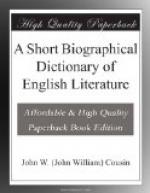To the Nightingale and On arriving at the
Age of Twenty-three, in 1631. In 1632, having
given up the idea of entering the Church, for which
his f. had intended him, he lived for 6 years
at Horton, near Windsor, to which the latter had retired,
devoted to further study. Here he wrote L’Allegro
and Il Penseroso in 1632, Arcades (1633),
Comus in 1634, and Lycidas in 1637.
The first celebrates the pleasures of a life of cheerful
innocence, and the second of contemplative, though
not gloomy, retirement, and the last is a lament for
a lost friend, Edward King, who perished at sea. Arcades
and Comus are masques set to music by Henry
Lawes, having for their motives respectively family
affection and maiden purity. Had he written nothing
else these would have given him a place among the
immortals. In 1638 he completed his education
by a period of travel in France and Italy, where he
visited Grotius at Paris, and Galileo at Florence.
The news of impending troubles in Church and State
brought him home the following year, and with his return
may be said to close the first of three well-marked
divisions into which his life falls. These may
be called (1) the period of preparation and of the
early poems; (2) the period of controversy, and of
the prose writings; and (3) the period of retirement
and of the later poems. Soon after his return
M. settled in London, and employed himself in teaching
his nephews, Edward and John Phillips, turning over
in his mind at the same time various subjects as the
possible theme for the great poem which, as the chief
object of his life, he looked forward to writing.
But he was soon to be called away to far other matters,
and to be plunged into the controversies and practical
business which were to absorb his energies for the
next 20 years. The works of this period fall into
three classes—(1) those directed against
Episcopacy, including Reformation of Church Discipline
in England (1641), and his answers to the writings
of Bishop Hall (q.v.), and in defence of Smectymnuus
(see under Calamy); (2) those relating to divorce,
including The Doctrine and Discipline of Divorce
(1643), and The Four Chief Places of Scripture
which treat of Marriage (1645); and (3) those on
political and miscellaneous questions, including the
Tractate on Education (1644), Areopagitica
(1644), A Speech for the Liberty of Unlicensed Printing
(his greatest prose work), Eikonoklastes, an
answer to the Eikon Basilike of Dr. Gauden
(q.v.), The Tenure of Kings and Magistrates
(1649), in defence of the execution of Charles I.,
which led to the furious controversy with Salmasius,
the writing of Pro Populo Anglicano Defensio
(1650), the second Defensio (1654), which carried
his name over Europe, and The Ready and Easy Way
to establish a Free Commonwealth, written on the
eve of the Restoration. In 1643 M. had m.




